Evaluating Debt, Dividend Policies on Shareholder Wealth (Finance)
VerifiedAdded on 2020/01/28
|12
|3801
|46
Report
AI Summary
This report delves into the intricate relationship between financial management, debt, dividend policies, and shareholder wealth. It critically evaluates how the inclusion of debt affects a firm's financial structure and the wealth of its shareholders, emphasizing the importance of an optimal capital structure. The report analyzes the impact of dividend policies on shareholder wealth, examining how companies like Tesco PLC and Barclays bank have been affected by financial crises and debt levels. It explores real-world scenarios, such as Tesco's debt-equity ratio and Barclays' dividend trends, to illustrate the practical implications of financial decisions. The analysis covers key financial metrics like earnings per share (EPS) and the weighted average cost of capital (WACC), offering insights into how businesses can maximize shareholder value and maintain financial stability. The report highlights the need for strategic financial planning to navigate economic challenges and make informed decisions about debt and dividend strategies.

Financial Management
Paraphrase This Document
Need a fresh take? Get an instant paraphrase of this document with our AI Paraphraser

Table of Contents
INTRODUCTION...........................................................................................................................3
A. Critically evaluating the impact of debt on shareholders wealth............................................3
B. Critically evaluate the potential impact of shareholders wealth on the dividend policy of
firm..............................................................................................................................................6
CONCLUSION................................................................................................................................9
REFERENCES..............................................................................................................................10
INTRODUCTION...........................................................................................................................3
A. Critically evaluating the impact of debt on shareholders wealth............................................3
B. Critically evaluate the potential impact of shareholders wealth on the dividend policy of
firm..............................................................................................................................................6
CONCLUSION................................................................................................................................9
REFERENCES..............................................................................................................................10
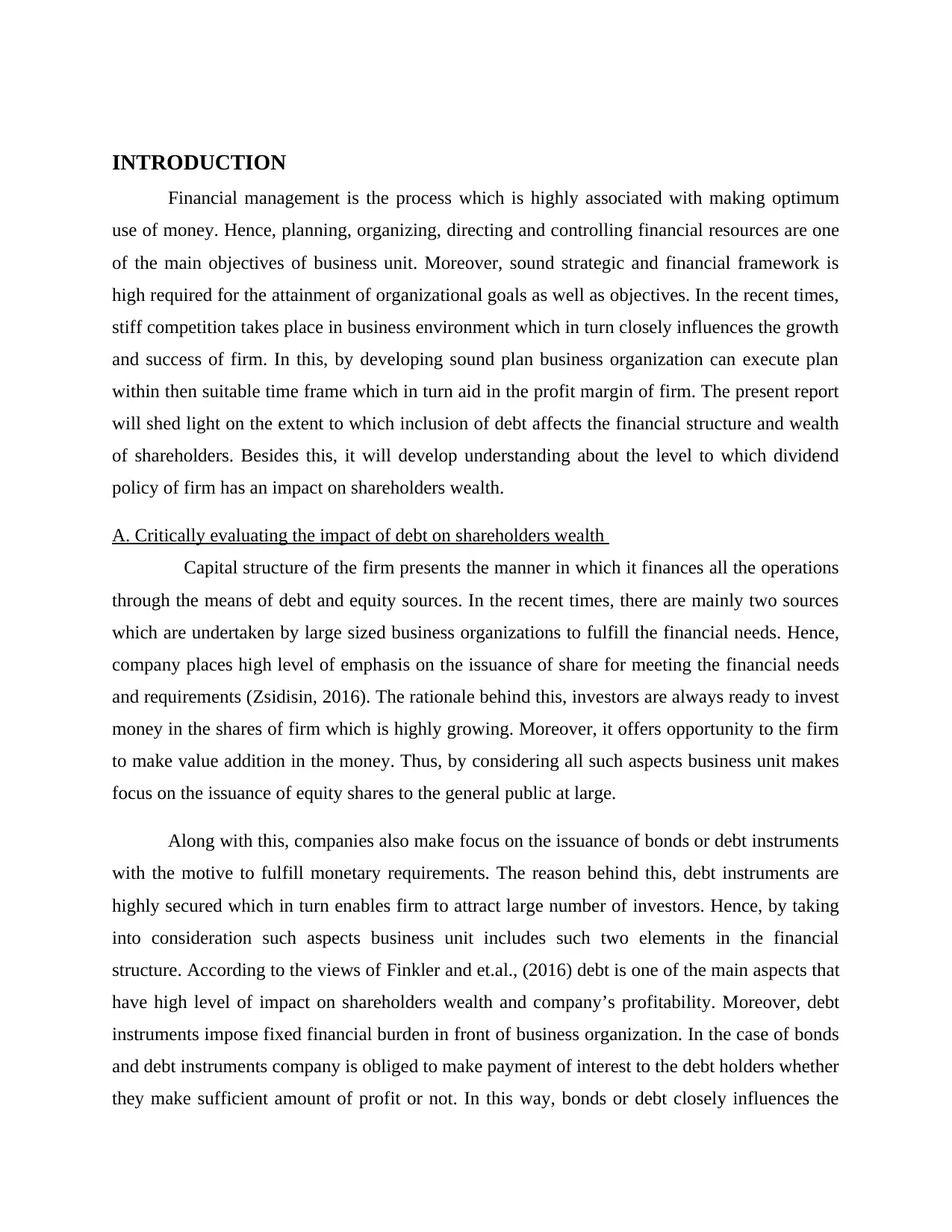
INTRODUCTION
Financial management is the process which is highly associated with making optimum
use of money. Hence, planning, organizing, directing and controlling financial resources are one
of the main objectives of business unit. Moreover, sound strategic and financial framework is
high required for the attainment of organizational goals as well as objectives. In the recent times,
stiff competition takes place in business environment which in turn closely influences the growth
and success of firm. In this, by developing sound plan business organization can execute plan
within then suitable time frame which in turn aid in the profit margin of firm. The present report
will shed light on the extent to which inclusion of debt affects the financial structure and wealth
of shareholders. Besides this, it will develop understanding about the level to which dividend
policy of firm has an impact on shareholders wealth.
A. Critically evaluating the impact of debt on shareholders wealth
Capital structure of the firm presents the manner in which it finances all the operations
through the means of debt and equity sources. In the recent times, there are mainly two sources
which are undertaken by large sized business organizations to fulfill the financial needs. Hence,
company places high level of emphasis on the issuance of share for meeting the financial needs
and requirements (Zsidisin, 2016). The rationale behind this, investors are always ready to invest
money in the shares of firm which is highly growing. Moreover, it offers opportunity to the firm
to make value addition in the money. Thus, by considering all such aspects business unit makes
focus on the issuance of equity shares to the general public at large.
Along with this, companies also make focus on the issuance of bonds or debt instruments
with the motive to fulfill monetary requirements. The reason behind this, debt instruments are
highly secured which in turn enables firm to attract large number of investors. Hence, by taking
into consideration such aspects business unit includes such two elements in the financial
structure. According to the views of Finkler and et.al., (2016) debt is one of the main aspects that
have high level of impact on shareholders wealth and company’s profitability. Moreover, debt
instruments impose fixed financial burden in front of business organization. In the case of bonds
and debt instruments company is obliged to make payment of interest to the debt holders whether
they make sufficient amount of profit or not. In this way, bonds or debt closely influences the
Financial management is the process which is highly associated with making optimum
use of money. Hence, planning, organizing, directing and controlling financial resources are one
of the main objectives of business unit. Moreover, sound strategic and financial framework is
high required for the attainment of organizational goals as well as objectives. In the recent times,
stiff competition takes place in business environment which in turn closely influences the growth
and success of firm. In this, by developing sound plan business organization can execute plan
within then suitable time frame which in turn aid in the profit margin of firm. The present report
will shed light on the extent to which inclusion of debt affects the financial structure and wealth
of shareholders. Besides this, it will develop understanding about the level to which dividend
policy of firm has an impact on shareholders wealth.
A. Critically evaluating the impact of debt on shareholders wealth
Capital structure of the firm presents the manner in which it finances all the operations
through the means of debt and equity sources. In the recent times, there are mainly two sources
which are undertaken by large sized business organizations to fulfill the financial needs. Hence,
company places high level of emphasis on the issuance of share for meeting the financial needs
and requirements (Zsidisin, 2016). The rationale behind this, investors are always ready to invest
money in the shares of firm which is highly growing. Moreover, it offers opportunity to the firm
to make value addition in the money. Thus, by considering all such aspects business unit makes
focus on the issuance of equity shares to the general public at large.
Along with this, companies also make focus on the issuance of bonds or debt instruments
with the motive to fulfill monetary requirements. The reason behind this, debt instruments are
highly secured which in turn enables firm to attract large number of investors. Hence, by taking
into consideration such aspects business unit includes such two elements in the financial
structure. According to the views of Finkler and et.al., (2016) debt is one of the main aspects that
have high level of impact on shareholders wealth and company’s profitability. Moreover, debt
instruments impose fixed financial burden in front of business organization. In the case of bonds
and debt instruments company is obliged to make payment of interest to the debt holders whether
they make sufficient amount of profit or not. In this way, bonds or debt closely influences the
⊘ This is a preview!⊘
Do you want full access?
Subscribe today to unlock all pages.

Trusted by 1+ million students worldwide

profit margin of firm. Further, such aspect also influences the dividend decision of firm.
Moreover, company pays dividend to the shareholders from the profit amount which it has after
the fulfillment of all financial obligations. In this way, dividend decision of the company is
highly influenced from the extent to which capital structure of firm contains high debt.
In accordance with the views of Bir (2016) business units need to place emphasis on
maintaining ideal ratio while determining the capital structure of firm. Ideal ratio such as .5:1
entails that company must issue 1 debt instrument namely bond in against to 2 equity shares.
This in turn helps company in developing sound and effectual financial structure. Goal or
objective of each and every business organization is to develop highly optimal capital structure
which in turn helps in increasing the share price. Along with this, maintenance of minimum cost
of capital is another main objective of business organization. In this regard, by following ideal
ratio business unit can build and maintain highly effectual financial structure. The reason behind
this, capital structure has high level of impact on the financial performance and profitability
aspect of firm.
Along with this, such aspect also influences the profit margin of firm. Thus, for
increasing the shareholders wealth and decreasing the cost of capital firm is required to lay
emphasis on developing as well as maintaining optimal structure. Hence, debt-equity mix which
increases the wealth of shareholders is recognized as suitable capital structure. Thus, by
developing suitable structure business unit can maximize the wealth of shareholders to the
significant level (Leland, 2017). For instance: If business organization wants to provide
shareholders with high return then they need to include less debt in the financial structure.
Moreover, in the case of bonds or debenture business unit is obliged to make payment of interest
which directly affects the profit margin. In this way, by reducing the tax burden business unit can
enhance its profitability aspect and thereby would become able to offer higher return to the
shareholders in the form of dividend. Hence, by offering higher return to the shareholders
company can increase the value of firm. Moreover, goodwill of the business organization is
enhanced in the market when investors are highly satisfied from the return or dividend aspect.
However, on the critical note, Geske, Subrahmanyam and Zhou (2016) said that
decreasing WACC may result into incline in the value of firm. Hence, by following such aspect
highly optimal capital structure can be developed by the company. Nevertheless, there is lack of
Moreover, company pays dividend to the shareholders from the profit amount which it has after
the fulfillment of all financial obligations. In this way, dividend decision of the company is
highly influenced from the extent to which capital structure of firm contains high debt.
In accordance with the views of Bir (2016) business units need to place emphasis on
maintaining ideal ratio while determining the capital structure of firm. Ideal ratio such as .5:1
entails that company must issue 1 debt instrument namely bond in against to 2 equity shares.
This in turn helps company in developing sound and effectual financial structure. Goal or
objective of each and every business organization is to develop highly optimal capital structure
which in turn helps in increasing the share price. Along with this, maintenance of minimum cost
of capital is another main objective of business organization. In this regard, by following ideal
ratio business unit can build and maintain highly effectual financial structure. The reason behind
this, capital structure has high level of impact on the financial performance and profitability
aspect of firm.
Along with this, such aspect also influences the profit margin of firm. Thus, for
increasing the shareholders wealth and decreasing the cost of capital firm is required to lay
emphasis on developing as well as maintaining optimal structure. Hence, debt-equity mix which
increases the wealth of shareholders is recognized as suitable capital structure. Thus, by
developing suitable structure business unit can maximize the wealth of shareholders to the
significant level (Leland, 2017). For instance: If business organization wants to provide
shareholders with high return then they need to include less debt in the financial structure.
Moreover, in the case of bonds or debenture business unit is obliged to make payment of interest
which directly affects the profit margin. In this way, by reducing the tax burden business unit can
enhance its profitability aspect and thereby would become able to offer higher return to the
shareholders in the form of dividend. Hence, by offering higher return to the shareholders
company can increase the value of firm. Moreover, goodwill of the business organization is
enhanced in the market when investors are highly satisfied from the return or dividend aspect.
However, on the critical note, Geske, Subrahmanyam and Zhou (2016) said that
decreasing WACC may result into incline in the value of firm. Hence, by following such aspect
highly optimal capital structure can be developed by the company. Nevertheless, there is lack of
Paraphrase This Document
Need a fresh take? Get an instant paraphrase of this document with our AI Paraphraser
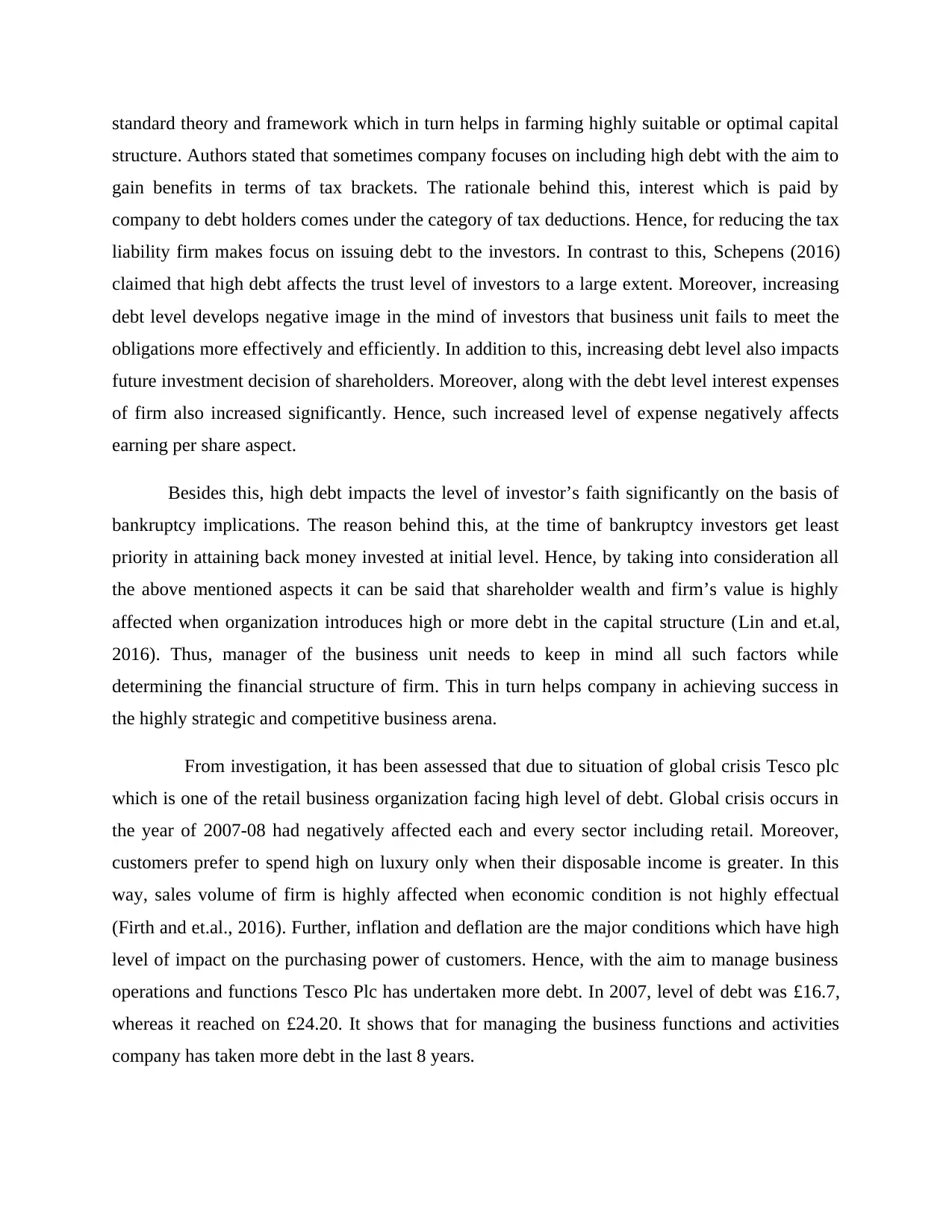
standard theory and framework which in turn helps in farming highly suitable or optimal capital
structure. Authors stated that sometimes company focuses on including high debt with the aim to
gain benefits in terms of tax brackets. The rationale behind this, interest which is paid by
company to debt holders comes under the category of tax deductions. Hence, for reducing the tax
liability firm makes focus on issuing debt to the investors. In contrast to this, Schepens (2016)
claimed that high debt affects the trust level of investors to a large extent. Moreover, increasing
debt level develops negative image in the mind of investors that business unit fails to meet the
obligations more effectively and efficiently. In addition to this, increasing debt level also impacts
future investment decision of shareholders. Moreover, along with the debt level interest expenses
of firm also increased significantly. Hence, such increased level of expense negatively affects
earning per share aspect.
Besides this, high debt impacts the level of investor’s faith significantly on the basis of
bankruptcy implications. The reason behind this, at the time of bankruptcy investors get least
priority in attaining back money invested at initial level. Hence, by taking into consideration all
the above mentioned aspects it can be said that shareholder wealth and firm’s value is highly
affected when organization introduces high or more debt in the capital structure (Lin and et.al,
2016). Thus, manager of the business unit needs to keep in mind all such factors while
determining the financial structure of firm. This in turn helps company in achieving success in
the highly strategic and competitive business arena.
From investigation, it has been assessed that due to situation of global crisis Tesco plc
which is one of the retail business organization facing high level of debt. Global crisis occurs in
the year of 2007-08 had negatively affected each and every sector including retail. Moreover,
customers prefer to spend high on luxury only when their disposable income is greater. In this
way, sales volume of firm is highly affected when economic condition is not highly effectual
(Firth and et.al., 2016). Further, inflation and deflation are the major conditions which have high
level of impact on the purchasing power of customers. Hence, with the aim to manage business
operations and functions Tesco Plc has undertaken more debt. In 2007, level of debt was £16.7,
whereas it reached on £24.20. It shows that for managing the business functions and activities
company has taken more debt in the last 8 years.
structure. Authors stated that sometimes company focuses on including high debt with the aim to
gain benefits in terms of tax brackets. The rationale behind this, interest which is paid by
company to debt holders comes under the category of tax deductions. Hence, for reducing the tax
liability firm makes focus on issuing debt to the investors. In contrast to this, Schepens (2016)
claimed that high debt affects the trust level of investors to a large extent. Moreover, increasing
debt level develops negative image in the mind of investors that business unit fails to meet the
obligations more effectively and efficiently. In addition to this, increasing debt level also impacts
future investment decision of shareholders. Moreover, along with the debt level interest expenses
of firm also increased significantly. Hence, such increased level of expense negatively affects
earning per share aspect.
Besides this, high debt impacts the level of investor’s faith significantly on the basis of
bankruptcy implications. The reason behind this, at the time of bankruptcy investors get least
priority in attaining back money invested at initial level. Hence, by taking into consideration all
the above mentioned aspects it can be said that shareholder wealth and firm’s value is highly
affected when organization introduces high or more debt in the capital structure (Lin and et.al,
2016). Thus, manager of the business unit needs to keep in mind all such factors while
determining the financial structure of firm. This in turn helps company in achieving success in
the highly strategic and competitive business arena.
From investigation, it has been assessed that due to situation of global crisis Tesco plc
which is one of the retail business organization facing high level of debt. Global crisis occurs in
the year of 2007-08 had negatively affected each and every sector including retail. Moreover,
customers prefer to spend high on luxury only when their disposable income is greater. In this
way, sales volume of firm is highly affected when economic condition is not highly effectual
(Firth and et.al., 2016). Further, inflation and deflation are the major conditions which have high
level of impact on the purchasing power of customers. Hence, with the aim to manage business
operations and functions Tesco Plc has undertaken more debt. In 2007, level of debt was £16.7,
whereas it reached on £24.20. It shows that for managing the business functions and activities
company has taken more debt in the last 8 years.
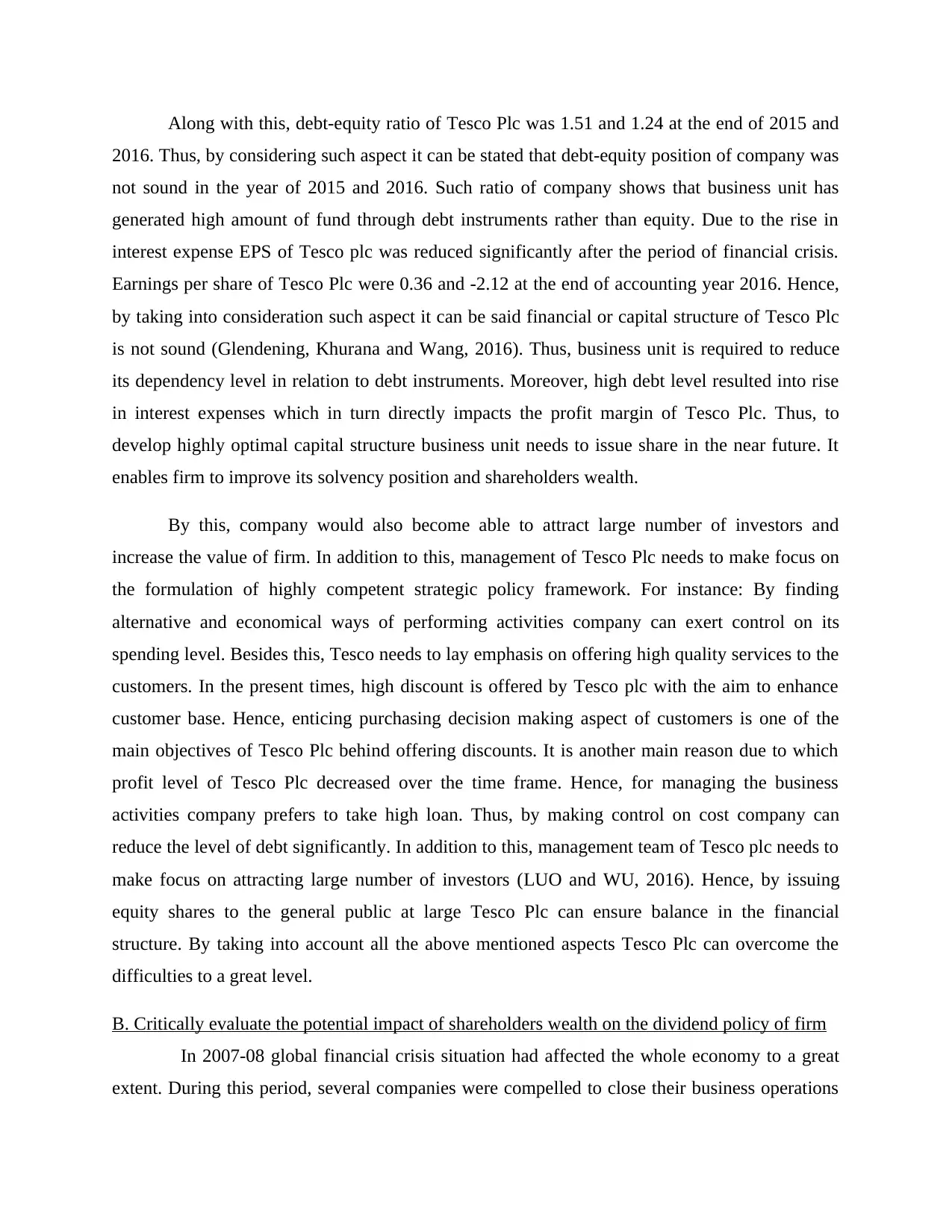
Along with this, debt-equity ratio of Tesco Plc was 1.51 and 1.24 at the end of 2015 and
2016. Thus, by considering such aspect it can be stated that debt-equity position of company was
not sound in the year of 2015 and 2016. Such ratio of company shows that business unit has
generated high amount of fund through debt instruments rather than equity. Due to the rise in
interest expense EPS of Tesco plc was reduced significantly after the period of financial crisis.
Earnings per share of Tesco Plc were 0.36 and -2.12 at the end of accounting year 2016. Hence,
by taking into consideration such aspect it can be said financial or capital structure of Tesco Plc
is not sound (Glendening, Khurana and Wang, 2016). Thus, business unit is required to reduce
its dependency level in relation to debt instruments. Moreover, high debt level resulted into rise
in interest expenses which in turn directly impacts the profit margin of Tesco Plc. Thus, to
develop highly optimal capital structure business unit needs to issue share in the near future. It
enables firm to improve its solvency position and shareholders wealth.
By this, company would also become able to attract large number of investors and
increase the value of firm. In addition to this, management of Tesco Plc needs to make focus on
the formulation of highly competent strategic policy framework. For instance: By finding
alternative and economical ways of performing activities company can exert control on its
spending level. Besides this, Tesco needs to lay emphasis on offering high quality services to the
customers. In the present times, high discount is offered by Tesco plc with the aim to enhance
customer base. Hence, enticing purchasing decision making aspect of customers is one of the
main objectives of Tesco Plc behind offering discounts. It is another main reason due to which
profit level of Tesco Plc decreased over the time frame. Hence, for managing the business
activities company prefers to take high loan. Thus, by making control on cost company can
reduce the level of debt significantly. In addition to this, management team of Tesco plc needs to
make focus on attracting large number of investors (LUO and WU, 2016). Hence, by issuing
equity shares to the general public at large Tesco Plc can ensure balance in the financial
structure. By taking into account all the above mentioned aspects Tesco Plc can overcome the
difficulties to a great level.
B. Critically evaluate the potential impact of shareholders wealth on the dividend policy of firm
In 2007-08 global financial crisis situation had affected the whole economy to a great
extent. During this period, several companies were compelled to close their business operations
2016. Thus, by considering such aspect it can be stated that debt-equity position of company was
not sound in the year of 2015 and 2016. Such ratio of company shows that business unit has
generated high amount of fund through debt instruments rather than equity. Due to the rise in
interest expense EPS of Tesco plc was reduced significantly after the period of financial crisis.
Earnings per share of Tesco Plc were 0.36 and -2.12 at the end of accounting year 2016. Hence,
by taking into consideration such aspect it can be said financial or capital structure of Tesco Plc
is not sound (Glendening, Khurana and Wang, 2016). Thus, business unit is required to reduce
its dependency level in relation to debt instruments. Moreover, high debt level resulted into rise
in interest expenses which in turn directly impacts the profit margin of Tesco Plc. Thus, to
develop highly optimal capital structure business unit needs to issue share in the near future. It
enables firm to improve its solvency position and shareholders wealth.
By this, company would also become able to attract large number of investors and
increase the value of firm. In addition to this, management of Tesco Plc needs to make focus on
the formulation of highly competent strategic policy framework. For instance: By finding
alternative and economical ways of performing activities company can exert control on its
spending level. Besides this, Tesco needs to lay emphasis on offering high quality services to the
customers. In the present times, high discount is offered by Tesco plc with the aim to enhance
customer base. Hence, enticing purchasing decision making aspect of customers is one of the
main objectives of Tesco Plc behind offering discounts. It is another main reason due to which
profit level of Tesco Plc decreased over the time frame. Hence, for managing the business
activities company prefers to take high loan. Thus, by making control on cost company can
reduce the level of debt significantly. In addition to this, management team of Tesco plc needs to
make focus on attracting large number of investors (LUO and WU, 2016). Hence, by issuing
equity shares to the general public at large Tesco Plc can ensure balance in the financial
structure. By taking into account all the above mentioned aspects Tesco Plc can overcome the
difficulties to a great level.
B. Critically evaluate the potential impact of shareholders wealth on the dividend policy of firm
In 2007-08 global financial crisis situation had affected the whole economy to a great
extent. During this period, several companies were compelled to close their business operations
⊘ This is a preview!⊘
Do you want full access?
Subscribe today to unlock all pages.

Trusted by 1+ million students worldwide
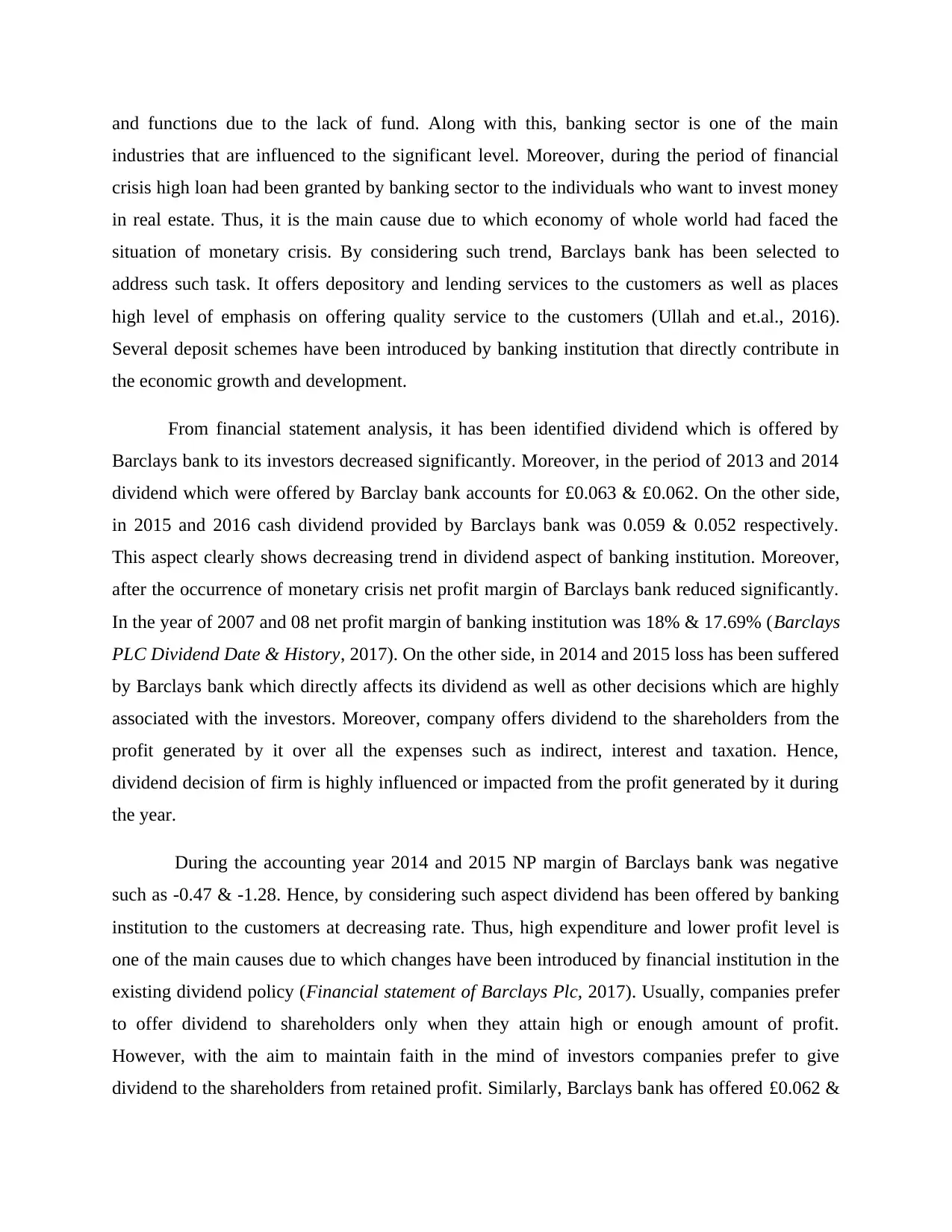
and functions due to the lack of fund. Along with this, banking sector is one of the main
industries that are influenced to the significant level. Moreover, during the period of financial
crisis high loan had been granted by banking sector to the individuals who want to invest money
in real estate. Thus, it is the main cause due to which economy of whole world had faced the
situation of monetary crisis. By considering such trend, Barclays bank has been selected to
address such task. It offers depository and lending services to the customers as well as places
high level of emphasis on offering quality service to the customers (Ullah and et.al., 2016).
Several deposit schemes have been introduced by banking institution that directly contribute in
the economic growth and development.
From financial statement analysis, it has been identified dividend which is offered by
Barclays bank to its investors decreased significantly. Moreover, in the period of 2013 and 2014
dividend which were offered by Barclay bank accounts for £0.063 & £0.062. On the other side,
in 2015 and 2016 cash dividend provided by Barclays bank was 0.059 & 0.052 respectively.
This aspect clearly shows decreasing trend in dividend aspect of banking institution. Moreover,
after the occurrence of monetary crisis net profit margin of Barclays bank reduced significantly.
In the year of 2007 and 08 net profit margin of banking institution was 18% & 17.69% (Barclays
PLC Dividend Date & History, 2017). On the other side, in 2014 and 2015 loss has been suffered
by Barclays bank which directly affects its dividend as well as other decisions which are highly
associated with the investors. Moreover, company offers dividend to the shareholders from the
profit generated by it over all the expenses such as indirect, interest and taxation. Hence,
dividend decision of firm is highly influenced or impacted from the profit generated by it during
the year.
During the accounting year 2014 and 2015 NP margin of Barclays bank was negative
such as -0.47 & -1.28. Hence, by considering such aspect dividend has been offered by banking
institution to the customers at decreasing rate. Thus, high expenditure and lower profit level is
one of the main causes due to which changes have been introduced by financial institution in the
existing dividend policy (Financial statement of Barclays Plc, 2017). Usually, companies prefer
to offer dividend to shareholders only when they attain high or enough amount of profit.
However, with the aim to maintain faith in the mind of investors companies prefer to give
dividend to the shareholders from retained profit. Similarly, Barclays bank has offered £0.062 &
industries that are influenced to the significant level. Moreover, during the period of financial
crisis high loan had been granted by banking sector to the individuals who want to invest money
in real estate. Thus, it is the main cause due to which economy of whole world had faced the
situation of monetary crisis. By considering such trend, Barclays bank has been selected to
address such task. It offers depository and lending services to the customers as well as places
high level of emphasis on offering quality service to the customers (Ullah and et.al., 2016).
Several deposit schemes have been introduced by banking institution that directly contribute in
the economic growth and development.
From financial statement analysis, it has been identified dividend which is offered by
Barclays bank to its investors decreased significantly. Moreover, in the period of 2013 and 2014
dividend which were offered by Barclay bank accounts for £0.063 & £0.062. On the other side,
in 2015 and 2016 cash dividend provided by Barclays bank was 0.059 & 0.052 respectively.
This aspect clearly shows decreasing trend in dividend aspect of banking institution. Moreover,
after the occurrence of monetary crisis net profit margin of Barclays bank reduced significantly.
In the year of 2007 and 08 net profit margin of banking institution was 18% & 17.69% (Barclays
PLC Dividend Date & History, 2017). On the other side, in 2014 and 2015 loss has been suffered
by Barclays bank which directly affects its dividend as well as other decisions which are highly
associated with the investors. Moreover, company offers dividend to the shareholders from the
profit generated by it over all the expenses such as indirect, interest and taxation. Hence,
dividend decision of firm is highly influenced or impacted from the profit generated by it during
the year.
During the accounting year 2014 and 2015 NP margin of Barclays bank was negative
such as -0.47 & -1.28. Hence, by considering such aspect dividend has been offered by banking
institution to the customers at decreasing rate. Thus, high expenditure and lower profit level is
one of the main causes due to which changes have been introduced by financial institution in the
existing dividend policy (Financial statement of Barclays Plc, 2017). Usually, companies prefer
to offer dividend to shareholders only when they attain high or enough amount of profit.
However, with the aim to maintain faith in the mind of investors companies prefer to give
dividend to the shareholders from retained profit. Similarly, Barclays bank has offered £0.062 &
Paraphrase This Document
Need a fresh take? Get an instant paraphrase of this document with our AI Paraphraser
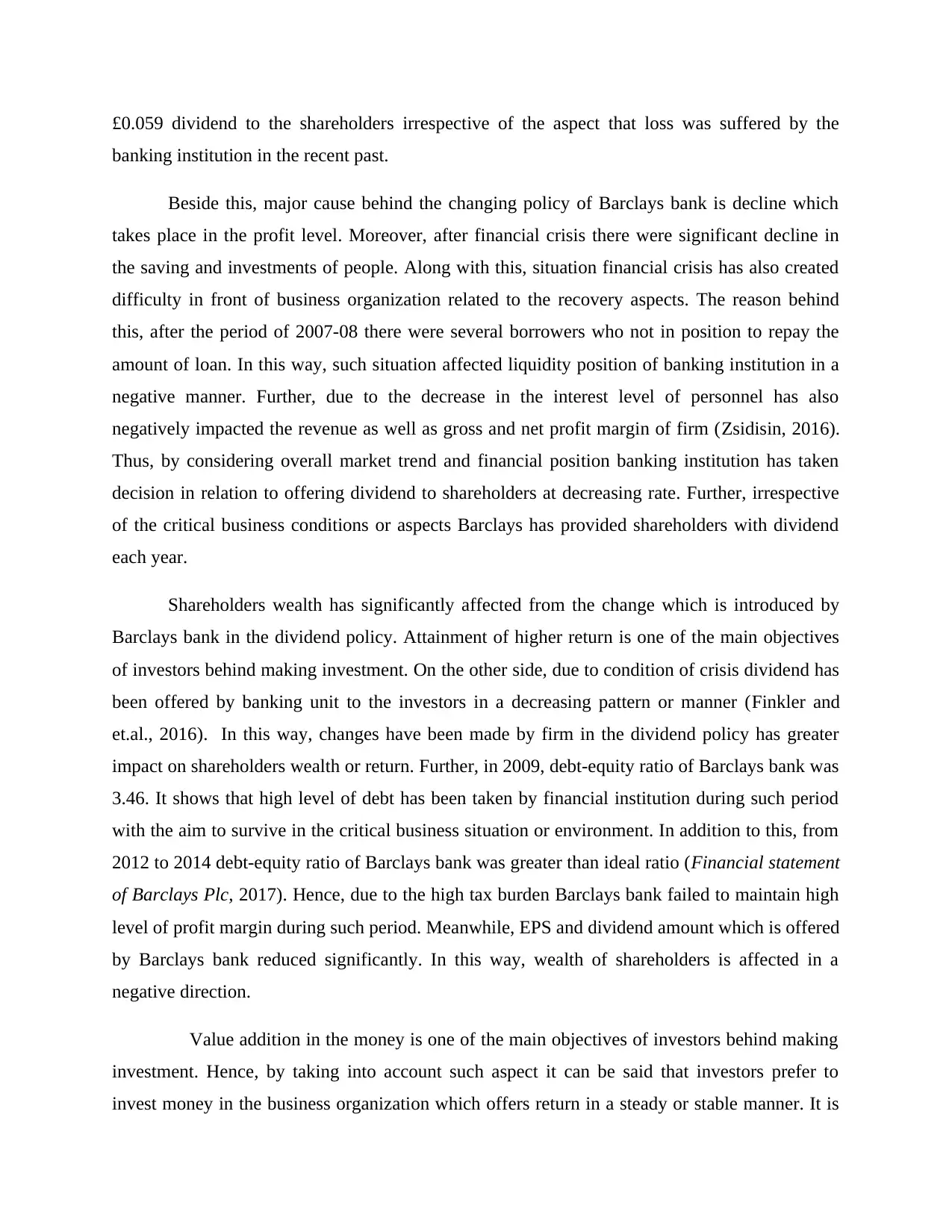
£0.059 dividend to the shareholders irrespective of the aspect that loss was suffered by the
banking institution in the recent past.
Beside this, major cause behind the changing policy of Barclays bank is decline which
takes place in the profit level. Moreover, after financial crisis there were significant decline in
the saving and investments of people. Along with this, situation financial crisis has also created
difficulty in front of business organization related to the recovery aspects. The reason behind
this, after the period of 2007-08 there were several borrowers who not in position to repay the
amount of loan. In this way, such situation affected liquidity position of banking institution in a
negative manner. Further, due to the decrease in the interest level of personnel has also
negatively impacted the revenue as well as gross and net profit margin of firm (Zsidisin, 2016).
Thus, by considering overall market trend and financial position banking institution has taken
decision in relation to offering dividend to shareholders at decreasing rate. Further, irrespective
of the critical business conditions or aspects Barclays has provided shareholders with dividend
each year.
Shareholders wealth has significantly affected from the change which is introduced by
Barclays bank in the dividend policy. Attainment of higher return is one of the main objectives
of investors behind making investment. On the other side, due to condition of crisis dividend has
been offered by banking unit to the investors in a decreasing pattern or manner (Finkler and
et.al., 2016). In this way, changes have been made by firm in the dividend policy has greater
impact on shareholders wealth or return. Further, in 2009, debt-equity ratio of Barclays bank was
3.46. It shows that high level of debt has been taken by financial institution during such period
with the aim to survive in the critical business situation or environment. In addition to this, from
2012 to 2014 debt-equity ratio of Barclays bank was greater than ideal ratio (Financial statement
of Barclays Plc, 2017). Hence, due to the high tax burden Barclays bank failed to maintain high
level of profit margin during such period. Meanwhile, EPS and dividend amount which is offered
by Barclays bank reduced significantly. In this way, wealth of shareholders is affected in a
negative direction.
Value addition in the money is one of the main objectives of investors behind making
investment. Hence, by taking into account such aspect it can be said that investors prefer to
invest money in the business organization which offers return in a steady or stable manner. It is
banking institution in the recent past.
Beside this, major cause behind the changing policy of Barclays bank is decline which
takes place in the profit level. Moreover, after financial crisis there were significant decline in
the saving and investments of people. Along with this, situation financial crisis has also created
difficulty in front of business organization related to the recovery aspects. The reason behind
this, after the period of 2007-08 there were several borrowers who not in position to repay the
amount of loan. In this way, such situation affected liquidity position of banking institution in a
negative manner. Further, due to the decrease in the interest level of personnel has also
negatively impacted the revenue as well as gross and net profit margin of firm (Zsidisin, 2016).
Thus, by considering overall market trend and financial position banking institution has taken
decision in relation to offering dividend to shareholders at decreasing rate. Further, irrespective
of the critical business conditions or aspects Barclays has provided shareholders with dividend
each year.
Shareholders wealth has significantly affected from the change which is introduced by
Barclays bank in the dividend policy. Attainment of higher return is one of the main objectives
of investors behind making investment. On the other side, due to condition of crisis dividend has
been offered by banking unit to the investors in a decreasing pattern or manner (Finkler and
et.al., 2016). In this way, changes have been made by firm in the dividend policy has greater
impact on shareholders wealth or return. Further, in 2009, debt-equity ratio of Barclays bank was
3.46. It shows that high level of debt has been taken by financial institution during such period
with the aim to survive in the critical business situation or environment. In addition to this, from
2012 to 2014 debt-equity ratio of Barclays bank was greater than ideal ratio (Financial statement
of Barclays Plc, 2017). Hence, due to the high tax burden Barclays bank failed to maintain high
level of profit margin during such period. Meanwhile, EPS and dividend amount which is offered
by Barclays bank reduced significantly. In this way, wealth of shareholders is affected in a
negative direction.
Value addition in the money is one of the main objectives of investors behind making
investment. Hence, by taking into account such aspect it can be said that investors prefer to
invest money in the business organization which offers return in a steady or stable manner. It is
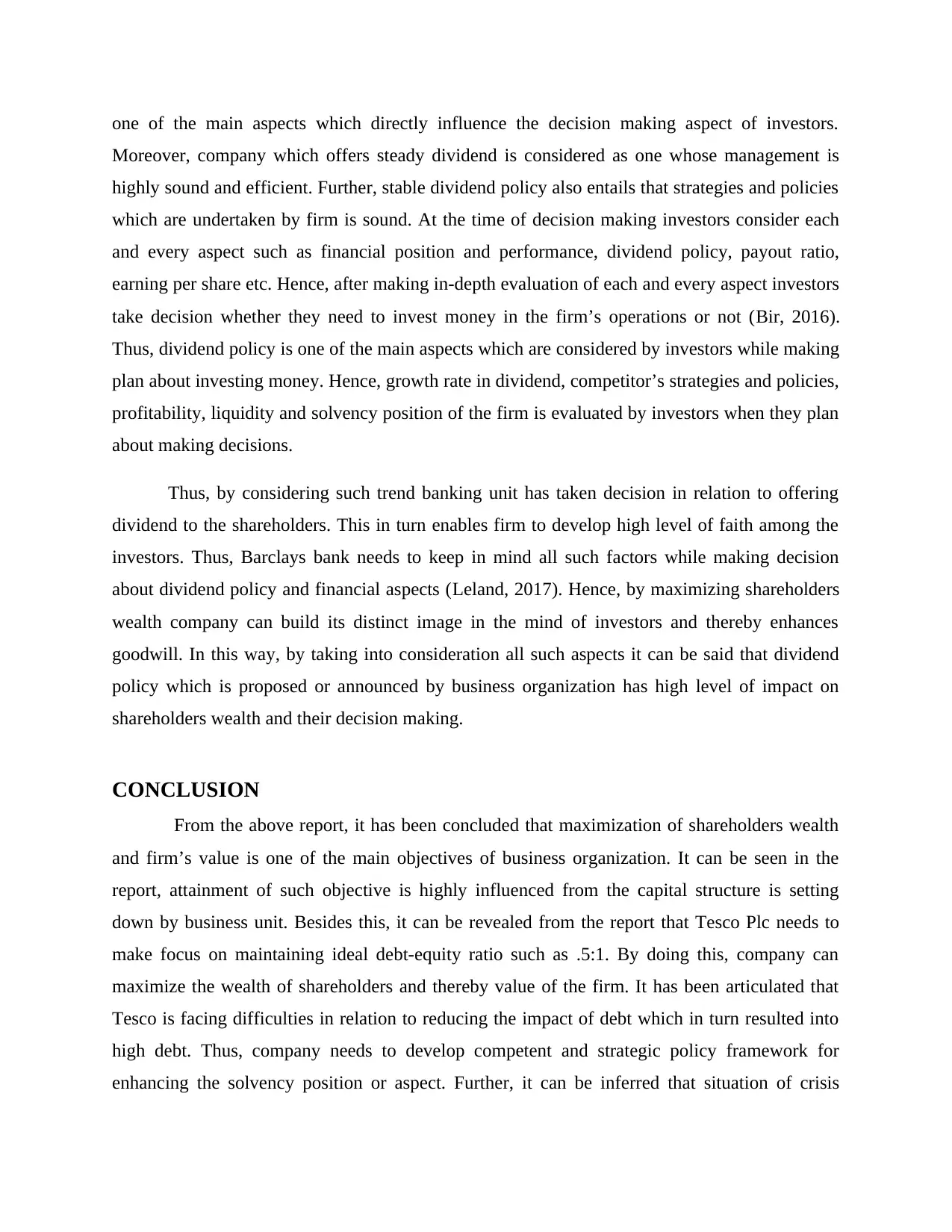
one of the main aspects which directly influence the decision making aspect of investors.
Moreover, company which offers steady dividend is considered as one whose management is
highly sound and efficient. Further, stable dividend policy also entails that strategies and policies
which are undertaken by firm is sound. At the time of decision making investors consider each
and every aspect such as financial position and performance, dividend policy, payout ratio,
earning per share etc. Hence, after making in-depth evaluation of each and every aspect investors
take decision whether they need to invest money in the firm’s operations or not (Bir, 2016).
Thus, dividend policy is one of the main aspects which are considered by investors while making
plan about investing money. Hence, growth rate in dividend, competitor’s strategies and policies,
profitability, liquidity and solvency position of the firm is evaluated by investors when they plan
about making decisions.
Thus, by considering such trend banking unit has taken decision in relation to offering
dividend to the shareholders. This in turn enables firm to develop high level of faith among the
investors. Thus, Barclays bank needs to keep in mind all such factors while making decision
about dividend policy and financial aspects (Leland, 2017). Hence, by maximizing shareholders
wealth company can build its distinct image in the mind of investors and thereby enhances
goodwill. In this way, by taking into consideration all such aspects it can be said that dividend
policy which is proposed or announced by business organization has high level of impact on
shareholders wealth and their decision making.
CONCLUSION
From the above report, it has been concluded that maximization of shareholders wealth
and firm’s value is one of the main objectives of business organization. It can be seen in the
report, attainment of such objective is highly influenced from the capital structure is setting
down by business unit. Besides this, it can be revealed from the report that Tesco Plc needs to
make focus on maintaining ideal debt-equity ratio such as .5:1. By doing this, company can
maximize the wealth of shareholders and thereby value of the firm. It has been articulated that
Tesco is facing difficulties in relation to reducing the impact of debt which in turn resulted into
high debt. Thus, company needs to develop competent and strategic policy framework for
enhancing the solvency position or aspect. Further, it can be inferred that situation of crisis
Moreover, company which offers steady dividend is considered as one whose management is
highly sound and efficient. Further, stable dividend policy also entails that strategies and policies
which are undertaken by firm is sound. At the time of decision making investors consider each
and every aspect such as financial position and performance, dividend policy, payout ratio,
earning per share etc. Hence, after making in-depth evaluation of each and every aspect investors
take decision whether they need to invest money in the firm’s operations or not (Bir, 2016).
Thus, dividend policy is one of the main aspects which are considered by investors while making
plan about investing money. Hence, growth rate in dividend, competitor’s strategies and policies,
profitability, liquidity and solvency position of the firm is evaluated by investors when they plan
about making decisions.
Thus, by considering such trend banking unit has taken decision in relation to offering
dividend to the shareholders. This in turn enables firm to develop high level of faith among the
investors. Thus, Barclays bank needs to keep in mind all such factors while making decision
about dividend policy and financial aspects (Leland, 2017). Hence, by maximizing shareholders
wealth company can build its distinct image in the mind of investors and thereby enhances
goodwill. In this way, by taking into consideration all such aspects it can be said that dividend
policy which is proposed or announced by business organization has high level of impact on
shareholders wealth and their decision making.
CONCLUSION
From the above report, it has been concluded that maximization of shareholders wealth
and firm’s value is one of the main objectives of business organization. It can be seen in the
report, attainment of such objective is highly influenced from the capital structure is setting
down by business unit. Besides this, it can be revealed from the report that Tesco Plc needs to
make focus on maintaining ideal debt-equity ratio such as .5:1. By doing this, company can
maximize the wealth of shareholders and thereby value of the firm. It has been articulated that
Tesco is facing difficulties in relation to reducing the impact of debt which in turn resulted into
high debt. Thus, company needs to develop competent and strategic policy framework for
enhancing the solvency position or aspect. Further, it can be inferred that situation of crisis
⊘ This is a preview!⊘
Do you want full access?
Subscribe today to unlock all pages.

Trusted by 1+ million students worldwide
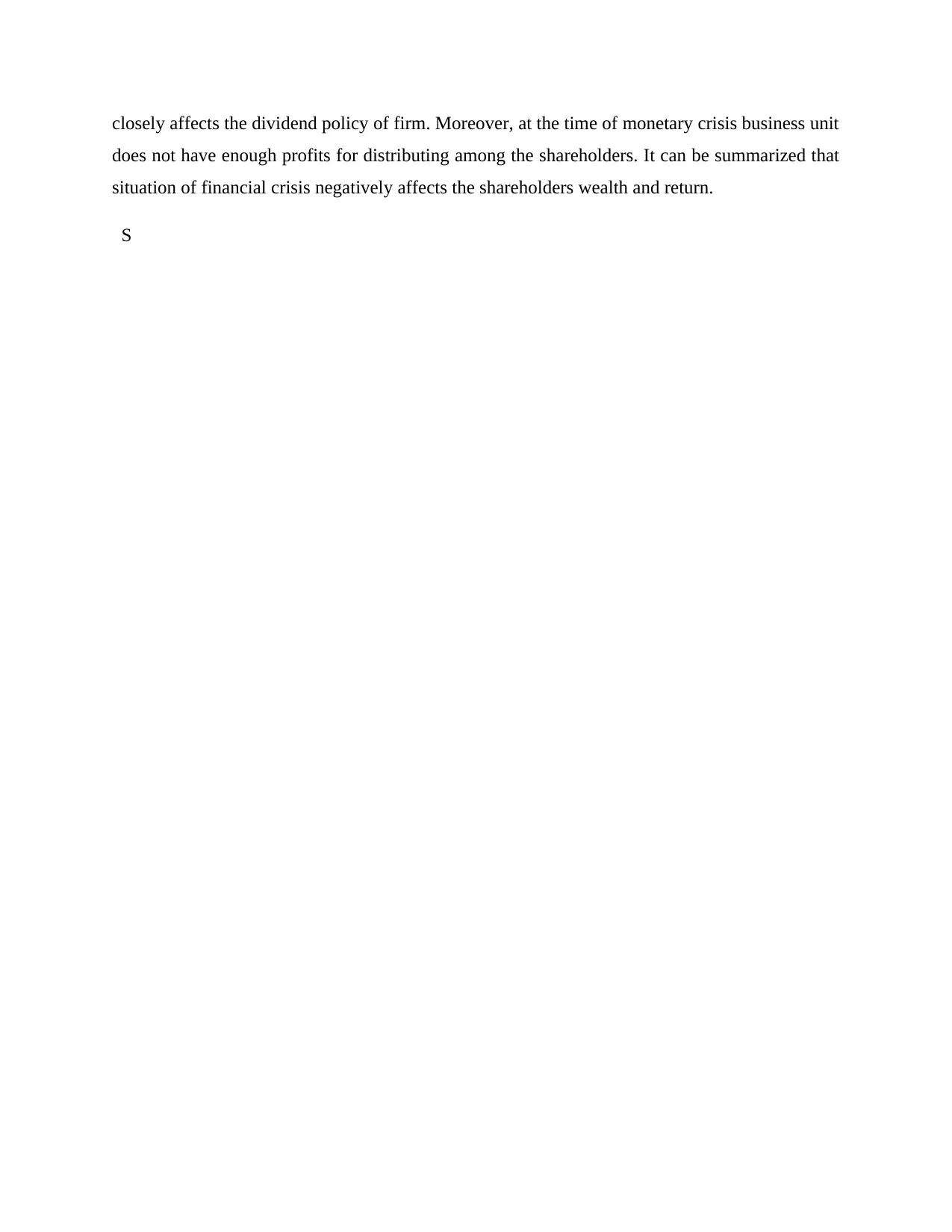
closely affects the dividend policy of firm. Moreover, at the time of monetary crisis business unit
does not have enough profits for distributing among the shareholders. It can be summarized that
situation of financial crisis negatively affects the shareholders wealth and return.
S
does not have enough profits for distributing among the shareholders. It can be summarized that
situation of financial crisis negatively affects the shareholders wealth and return.
S
Paraphrase This Document
Need a fresh take? Get an instant paraphrase of this document with our AI Paraphraser
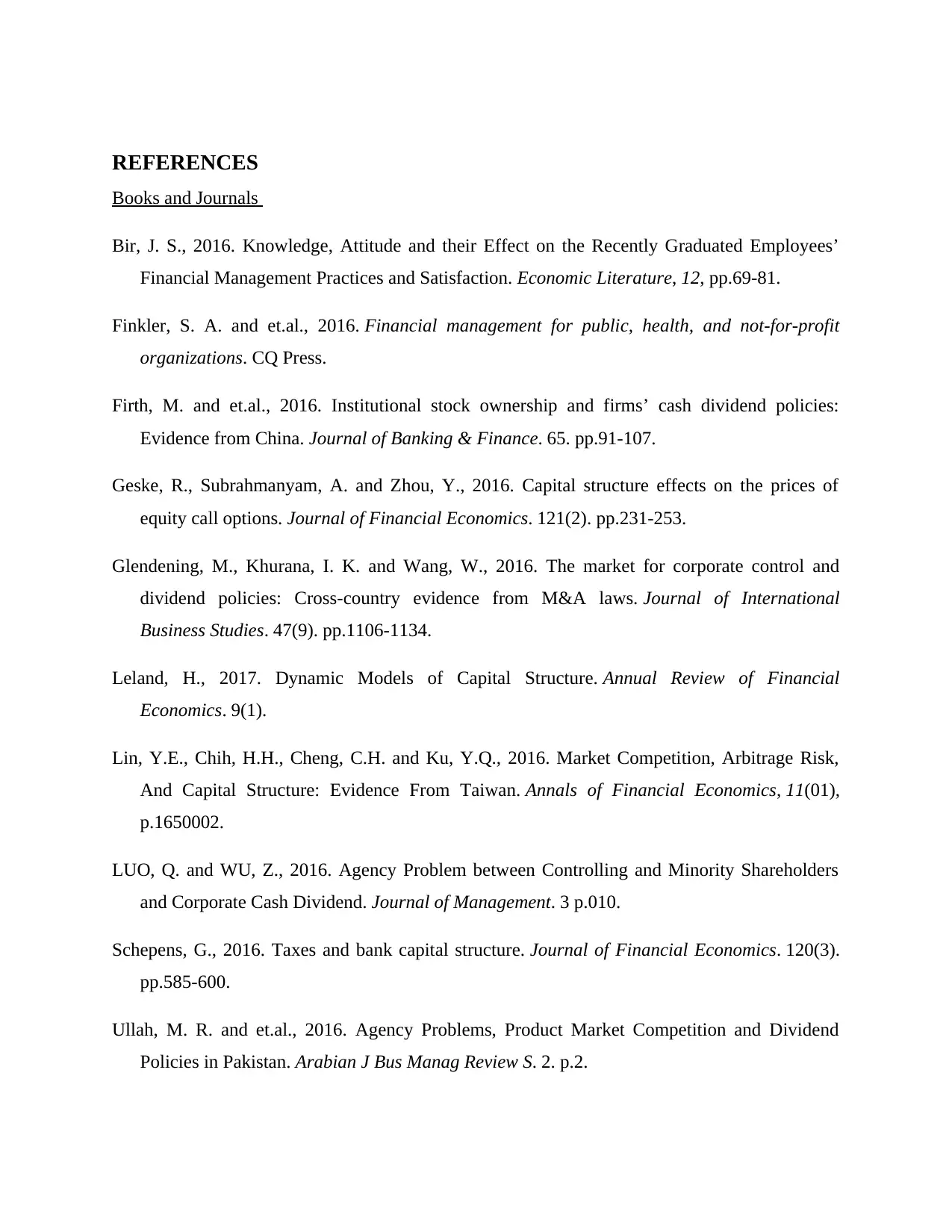
REFERENCES
Books and Journals
Bir, J. S., 2016. Knowledge, Attitude and their Effect on the Recently Graduated Employees’
Financial Management Practices and Satisfaction. Economic Literature, 12, pp.69-81.
Finkler, S. A. and et.al., 2016. Financial management for public, health, and not-for-profit
organizations. CQ Press.
Firth, M. and et.al., 2016. Institutional stock ownership and firms’ cash dividend policies:
Evidence from China. Journal of Banking & Finance. 65. pp.91-107.
Geske, R., Subrahmanyam, A. and Zhou, Y., 2016. Capital structure effects on the prices of
equity call options. Journal of Financial Economics. 121(2). pp.231-253.
Glendening, M., Khurana, I. K. and Wang, W., 2016. The market for corporate control and
dividend policies: Cross-country evidence from M&A laws. Journal of International
Business Studies. 47(9). pp.1106-1134.
Leland, H., 2017. Dynamic Models of Capital Structure. Annual Review of Financial
Economics. 9(1).
Lin, Y.E., Chih, H.H., Cheng, C.H. and Ku, Y.Q., 2016. Market Competition, Arbitrage Risk,
And Capital Structure: Evidence From Taiwan. Annals of Financial Economics, 11(01),
p.1650002.
LUO, Q. and WU, Z., 2016. Agency Problem between Controlling and Minority Shareholders
and Corporate Cash Dividend. Journal of Management. 3 p.010.
Schepens, G., 2016. Taxes and bank capital structure. Journal of Financial Economics. 120(3).
pp.585-600.
Ullah, M. R. and et.al., 2016. Agency Problems, Product Market Competition and Dividend
Policies in Pakistan. Arabian J Bus Manag Review S. 2. p.2.
Books and Journals
Bir, J. S., 2016. Knowledge, Attitude and their Effect on the Recently Graduated Employees’
Financial Management Practices and Satisfaction. Economic Literature, 12, pp.69-81.
Finkler, S. A. and et.al., 2016. Financial management for public, health, and not-for-profit
organizations. CQ Press.
Firth, M. and et.al., 2016. Institutional stock ownership and firms’ cash dividend policies:
Evidence from China. Journal of Banking & Finance. 65. pp.91-107.
Geske, R., Subrahmanyam, A. and Zhou, Y., 2016. Capital structure effects on the prices of
equity call options. Journal of Financial Economics. 121(2). pp.231-253.
Glendening, M., Khurana, I. K. and Wang, W., 2016. The market for corporate control and
dividend policies: Cross-country evidence from M&A laws. Journal of International
Business Studies. 47(9). pp.1106-1134.
Leland, H., 2017. Dynamic Models of Capital Structure. Annual Review of Financial
Economics. 9(1).
Lin, Y.E., Chih, H.H., Cheng, C.H. and Ku, Y.Q., 2016. Market Competition, Arbitrage Risk,
And Capital Structure: Evidence From Taiwan. Annals of Financial Economics, 11(01),
p.1650002.
LUO, Q. and WU, Z., 2016. Agency Problem between Controlling and Minority Shareholders
and Corporate Cash Dividend. Journal of Management. 3 p.010.
Schepens, G., 2016. Taxes and bank capital structure. Journal of Financial Economics. 120(3).
pp.585-600.
Ullah, M. R. and et.al., 2016. Agency Problems, Product Market Competition and Dividend
Policies in Pakistan. Arabian J Bus Manag Review S. 2. p.2.
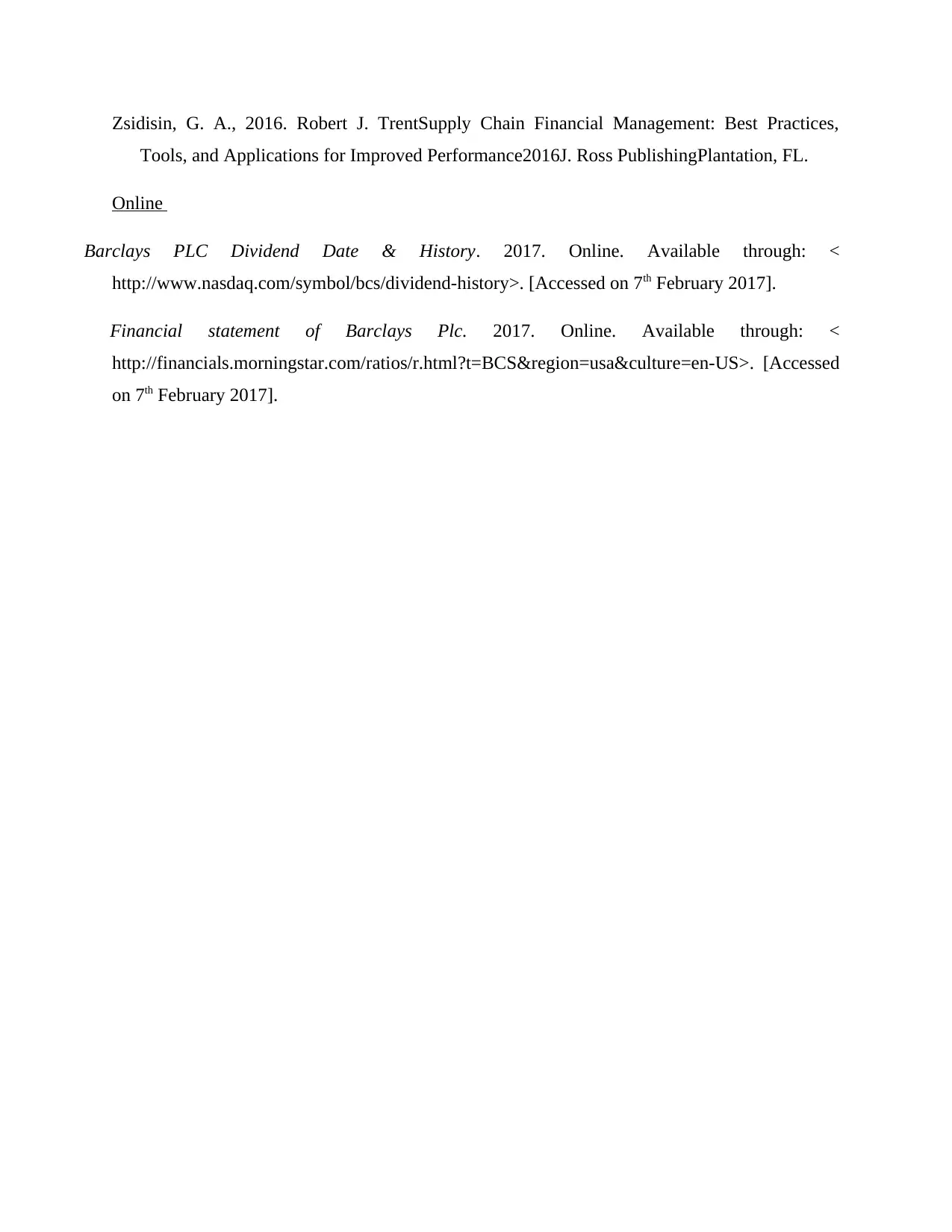
Zsidisin, G. A., 2016. Robert J. TrentSupply Chain Financial Management: Best Practices,
Tools, and Applications for Improved Performance2016J. Ross PublishingPlantation, FL.
Online
Barclays PLC Dividend Date & History. 2017. Online. Available through: <
http://www.nasdaq.com/symbol/bcs/dividend-history>. [Accessed on 7th February 2017].
Financial statement of Barclays Plc. 2017. Online. Available through: <
http://financials.morningstar.com/ratios/r.html?t=BCS®ion=usa&culture=en-US>. [Accessed
on 7th February 2017].
Tools, and Applications for Improved Performance2016J. Ross PublishingPlantation, FL.
Online
Barclays PLC Dividend Date & History. 2017. Online. Available through: <
http://www.nasdaq.com/symbol/bcs/dividend-history>. [Accessed on 7th February 2017].
Financial statement of Barclays Plc. 2017. Online. Available through: <
http://financials.morningstar.com/ratios/r.html?t=BCS®ion=usa&culture=en-US>. [Accessed
on 7th February 2017].
⊘ This is a preview!⊘
Do you want full access?
Subscribe today to unlock all pages.

Trusted by 1+ million students worldwide
1 out of 12
Related Documents
Your All-in-One AI-Powered Toolkit for Academic Success.
+13062052269
info@desklib.com
Available 24*7 on WhatsApp / Email
![[object Object]](/_next/static/media/star-bottom.7253800d.svg)
Unlock your academic potential
Copyright © 2020–2025 A2Z Services. All Rights Reserved. Developed and managed by ZUCOL.





